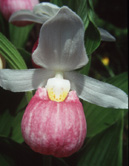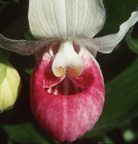Cypripedium reginae Walter
Showy lady's-slipper, queen lady's-slipper
The specific epithet reginae is the Latin meaning "queen."



Photos courtesy of Dan Aussem
DESCRIPTION: Plant robust,
arising from a rhizome with a fascicle of numerous fibrous roots, 25-90
cm high; several to many stems may arise from the same rootstock. Leaves
3-5, ovate, plicate, 10-25 cm long and 4-16 cm wide; densely pubescent.
Flowers 1-2(3), each subtended by a lanceolate green foliaceous bract
6-14 cm long by 3-7 cm wide. Sepals apparently two (the result of
the fusion of the two lateral sepals behind the labellum), white; dorsal
sepal ovate to obovate, 3-5 cm long and 2-3.5 cm wide; lateral sepals united,
white, ovate, 3-5 cm long and 1.5-3.5 cm wide. Petals white, lanceolate,
2.5-4 cm long and 1-1.5 cm wide. Labellum pouch-shaped, inflated,
spherical (or nearly so), 2.5-5.5 cm long, opening above with inrolled edges;
white suffused with deep rose to magenta, the veins often being white; rarely
the whole being white or rose.
SIMILAR SPECIES: Cypripedium reginae could probably be confused
only with other pinkishCypripedium species such as C.
acaule and C. arietinum. However,
it is easily separated from these two: the leaves of C.
acaule are always basal, and C. arietinum
is much smaller, with the labellum drawn out into a point.
HABITAT: Cypripedium reginae is found almost exclusively in calcareous
wetlands. In eastern Wisconsin, it is found in Thuja bogs, where
Fuller (1933) reports that its roots
are always found below the Sphagnum in the alkaline soil. Fuller
also reports that C. reginae is found in western Wisconsin in woodlands
along with C. calceolus var. pubescens
and other species of rich, circumneutral woodlands.
FLOWERING DATES: June 20 to July 5.
POLLINATION: Stoutamire (1967)
reports that Cypripedium reginae is pollinated by bees. Guignard
(1886, 1887) observed two species of Megachilid bees pollinating C.
reginae. There have also been reports of a small European skipper (a
non-native butterfly that is common throughout much of the range of C.
reginae) getting trapped in the labellum, and thus preventing pollination
by the bees. It is believed by some that this will result in a decline of
this species due to decreased reproduction. This speculation has not been
verified with detailed field work.
DISCUSSION: The pubescence of the leaves of Cypripedium reginae
can apparently produce a rash in some persons when it comes in contact with
the skin. This was detailed around the turn of the century by MacDougal
(1895). Unfortunately, this has not discouraged some people from collecting
this plant from the wild, and populations have suffered declines due to
over-collecting. Fortunately, there has been a tremendous amount of success
recently cultivating this species in captivity. A recent article in the
American Orchid Society Bulletin (Steele
1995) details the process for asymbiotic germination and cultivation
of C. reginae. Dr. Steele's lab, Spangle Creek Labs, sells cultivated
C. reginae and can be contacted at the following address: Spangle
Creek Labs, West 2802 Depot Springs Road, Spangle, Washington 99031.
WI DISTRIBUTION:  U.S. DISTRIBUTION:
U.S. DISTRIBUTION:
Go directly to Wisconsin herbarium records.
Return
to the main LIST of the Orchids of Wisconsin.
Return to the main KEY to the Orchids of
Wisconsin.



 U.S. DISTRIBUTION:
U.S. DISTRIBUTION: